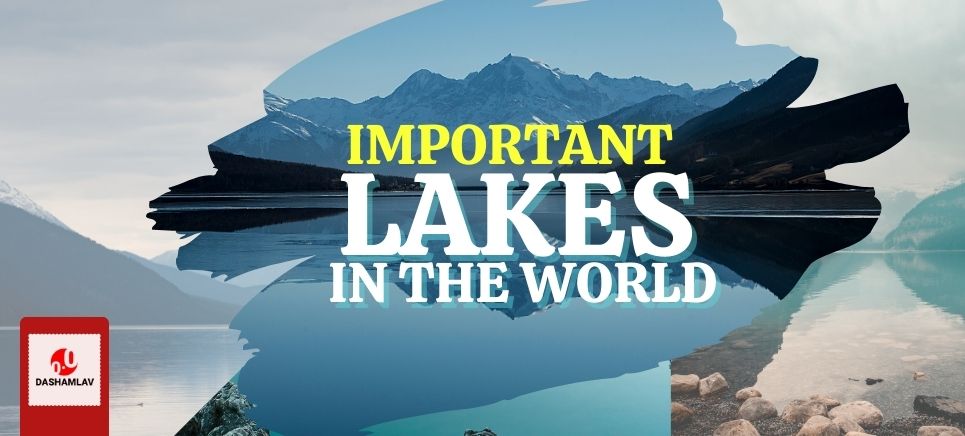A beautiful water body surrounded by land is what a lake stands for. There are over a hundred million lakes in the world. Amid this gigantic number, there exist some exclusive group lakes with a peculiar significance attached to them. From the location to size and salinity to depth, these lakes compel us to appreciate the creativity of mother nature. Let’s explore the details about some of the most important lakes in the world.
Which is the largest lake in the world?
There is no specific answer to this question as there are many parameters on which a lake can be determined as largest. Interestingly, the Caspian Sea tops the list of largest lakes on two fronts. It is the largest in terms of both surface area and volume. Thus, whenever a straight question like this one appears, you can always opt for the Caspian Sea!
Caspian Sea (Europe & Asia)
- With a vast surface area of 371,000 km2 (143,000 sq mi), the Caspian Sea is largest lake of the world by surface area.
- Caspian Sea lies between Europe & Asia. It is spread across five countries- Kazakhstan, (northeast), Turkmenistan (southeast), Iran, (south), Azerbaijan (west), and Russia (northwest).
- It is the world’s largest inland body of water with 18,761 cubic miles (78,200 cubic km) volume of water.
- The water of the Caspian Sea is salty though. After all, it has a salinity content of 1.2%. Hence, the Caspian Sea also holds the title of being the world’s largest saltwater lake.
Largest freshwater lake in the world: Lake Baikal or Lake Superior?
The answer is both unless you qualify the parameter. Lake Baikal (Russia) is the largest freshwater lake in the world by volume. On the other hand, Lake Superior (Located between Canada & the USA) is the largest freshwater lake in the world by surface area.

Lake Baikal (Siberia)
- With a water volume of 23,600 km3 (5,700 cu mi), Lake Baikal contains 22 to 23% of the total fresh surface water of the world.
- Lake Baikal is also the deepest and oldest lake in the world. It has a depth of 1,642 m (5,387 ft) and the lake is estimated to be over 25-30 million years old.
- It was declared as a World Heritage Site by UNESCO in 1996.
- The region around Lake Baikal is often referred to as Baikalia.
- During winters, Lake Baikal freezes over and a thick layer of ice covers the entire lake. The turquoise color of clear frozen lake water coupled with a beautiful circular pattern on the ice presents a spectacular view. Methane gases rising from the lake’s floor is responsible for the unique circular pattern. At times, these gases end up pushing the ice shards at odd angles.
Lake Superior (US & Canada)
- With a surface area of 82,100 km2 (31,700 sq mi), Lake Superior is the largest freshwater lake in the world by surface area and the third-largest freshwater lake by volume.
- It is the largest of the Great Lakes of North America spread across the US-Canada border.
- Some of the world’s oldest rocks are found near the Ontario shoreline of the lake. Almost 2.7 billion years old!
- Unlike Lake Baikal, Lake Superior rarely freezes over completely.
Lake Kariba (Africa): Largest man-made lake in the world
Located between Zimbabwe and Zambia, Lake Kariba is the largest man-made lake in the world. It is basically a water reservoir covering a surface area of 5,580 km2 (2,155 sq mi). Kariba Dam built in the Kariba Gorge of the Zambezi river basin forms the 223 kilometers (139 miles) long and 40 kilometers (25 miles) wide lake.
Lake Tanganyika (Africa): Longest freshwater lake in the world
Located in Africa, Lake Tanganyika is one of the largest of the Great African Lakes. With a length of 676 km (420 mi), it is the longest freshwater lake in the world. The lake drains into the Congo river system. Lake Tanganyika also holds the record of being the second-oldest freshwater lake, second-deepest lake, and second-largest freshwater lake by volume. The lake is spread across Tanzania, the Democratic Republic of Congo (DRC), Burundi, and Zambia.
Highest navigable lake in the world: Lake Titicaca (South America)
Lake Titicaca is the largest lake in South America both by volume and surface area. It is located in the Andes between Bolivia and Peru at a surface elevation of 3,812 m (12,507 ft). Lake Titicaca is the highest navigable lake in the world.
Use the citation below to add this article to your bibliography
"Important Lakes in the World: Largest, Deepest, Highest & Longest." Dashamlav.com. Web. 11 June 2025. <https://dashamlav.com/important-lakes-in-the-world-largest-deepest-highest-longest/>
Dashamlav.com, "Important Lakes in the World: Largest, Deepest, Highest & Longest." Accessed 11 June 2025. https://dashamlav.com/important-lakes-in-the-world-largest-deepest-highest-longest/
"Important Lakes in the World: Largest, Deepest, Highest & Longest." (n.d.). Dashamlav.com. Retrieved 11 June 2025 from https://dashamlav.com/important-lakes-in-the-world-largest-deepest-highest-longest/
